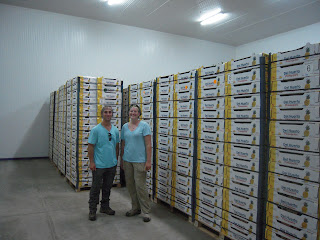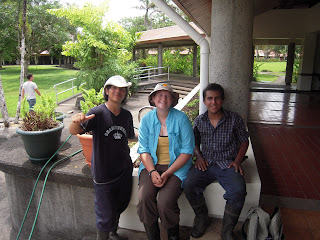Over the past three days I have been living with the Rodriguez family and have had a wonderful experience. Below you can see some photos about my time with the family, enjoy!
Here is me with my new family: Enid (the mom), Me, David (the other student with me), and Ronald. They also have a daughter Keirin that was with us the first night but then had to leave to go back to the University. As you can see in the background Ronald is a pineapple plantation owner. He has been working with pineapples for over 35 years now. He started out working in the fields as a poor farm worker and through the years has grown his business. Now he sells over one million dollars in pineapples each year which are exported all over the world. These are some of the nicest people that I have met and also some of the most hard working. Ronald goes goes goes all the time being a business owner and Enid is always right behind him making sure that everything on the home front goes smoothly. In the background you can see his ATV, which he is very proud of. I can't figure out why it is camouflage though. He uses this to ride around the plantation everyday to make sure that everything is alright.
This is a view from my families second home, or what they call their weekend home. This is a cabin that they come to every weekend which is located pretty much in the middle of nowhere surrounded by their pineapple plantation. As you can see they have a nice pool with a swim up bar as well as an amazing water slide into the pool. The coolest thing about this pool is the water in it is actually water runoff from the pineapple fields. He has a very good water management strategy that allows the water to go into the pool as well as his tilapia pools. The group had fun yesterday afternoon coming to visit and chilling at the pool. The family is very modest about this property and seems to have lots of events at this area where they invite the workers and their families to come and swim which helps keep up the moral and good relationships between the boss and the workers.
This is a picture of their two tilapia ponds. This is also water runoff from the fields and here they have a couple hundred tilapia in here that they actually harvest and eat. This seems to be a very common practice around Costa Rica for people to have their own tilapia ponds.
This is a picture of Ronald out cooking on the "grill" which is actually a part of an old tire. That night it was raining which is why the picture didn't turn out as well. He was funny because he kept wanting to add more charcoal to the grill but Enid kept telling him not too because it would cook to fast, so it was funny to listen to them canter back and forth.
The first night we were with the family, their daughter Keirin celebrated her 18th birthday. Here is the cake that Enid had gotten for her. As you can see since it was so hot there the icing was melting off of it before we could eat it. Here in Costa Rica 18 is the age for everything like getting your drivers license, voting, as well as drinking.
One morning David and I worked in the fields with the workers harvesting pineapples. Lets just say I have a very new appreciation for pineapples. The workers here start at 4:30 and usually work until about noon. We didn't arrive until 5:30 but the harvest was in full swing. As part of the harvesting process we had to wear some nice protective equipment. The first was like an apron but it went down and around your legs and we had arm guards. Even with this equipment our skin got tore up pretty bad just from the pineapple plants themselves. Here we are putting the pineapples in the crates, 10 per crates, which are then loaded up and taken to the processing plant. During our time we also learned how to break the pineapples off the plants. The workers that Ronald has are amazingly efficient and were putting us to shame, but we had a good time with it!
This is the room that I stayed in during my stay, it is actually Keirin's room when she is home. They have a very nice home and what David and I enjoyed the best was the air conditioning unit that was in the bedrooms, it was the first we have had since we were here. It was very nice to be able to have this nice luxury even for just a few nights!
This was my favorite "room" of the house which is actually the front patio. This is where everyone always seems to go since it is so hot inside the house during the day. Here it is nice and shaded and you can occasionally catch a nice breeze.
This is David and I when we went to tour the pineapple packaging plant where Ronald sends his pineapples. We had a great tour, which lasted 3 hours, where we learned all about the process and the history of pineapple growing in Costa Rica. Here we are standing in the refrigeration room where the pineapples are being kept until they are loaded into the trucks. The pineapples behind us are going to be sent to the UK. The plant we visited exports pineapples to over 15 different countries around the world. While we were there we also got to see some of Ronald's pineapple go through the system and get boxed up.
Yesterday some of us had the opportunity to work with a local conservation group and plant trees. This is the location that we planted the trees at. The hike in was a little bit long but the view was worth it and we planted about 50 trees. This group is in charge of the drinking water for a nearby town and they own the property where their is a natural spring. The property when they bought it was cleared for pasture land so they are planting trees and other vegetation which helps with issues such as soil erosion as well as helps purify the water.
While we were on the hillside we also had the opportunity to hike back into this waterfall which was so beautiful. The water coming out of this spring is also the water that the town uses and is dependent on.
My first waterfall of Costa Rica!
This is the view from where I am writing this blog today. We are at a bio-dynamic farm called Luna Nueva which is situated in the mountains of Costa Rica. This afternoon it has rained for awhile and then all of a sudden the fog moved in for a little while and then moved out very quickly. It is so beautiful though!
Tomorrow morning we will be going to Monteverde which is known for the Cloud Forest. In the afternoon we will be doing a forest tour getting ready for Saturday when we do the SkyWalk and the zip-line tour. I can't wait!!

















































